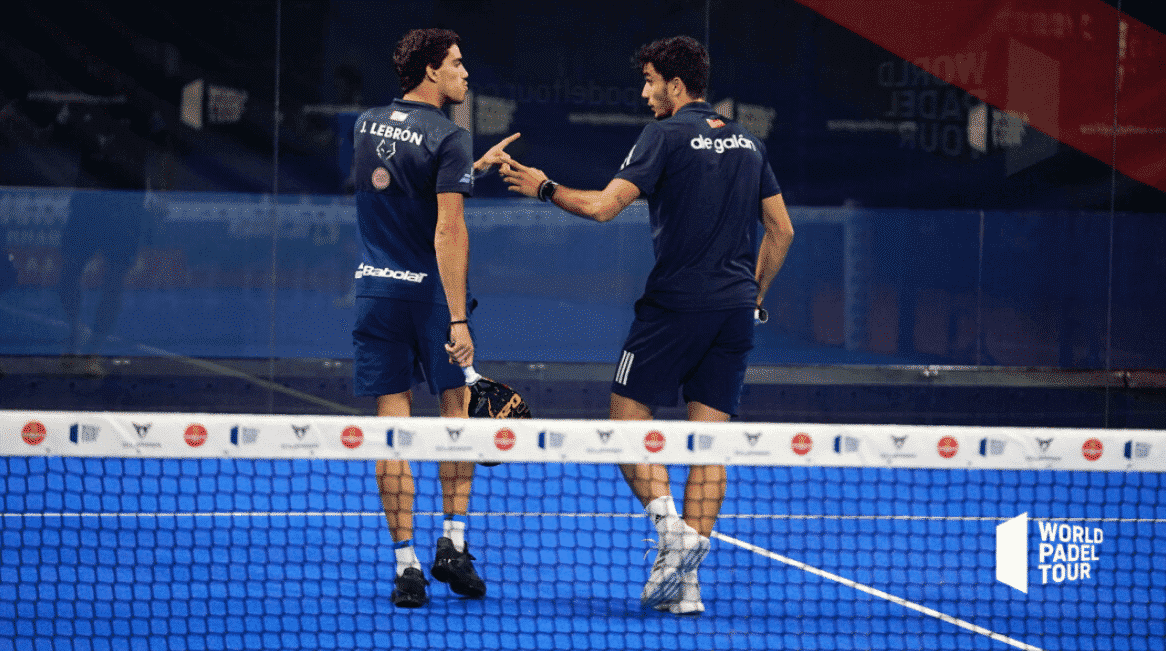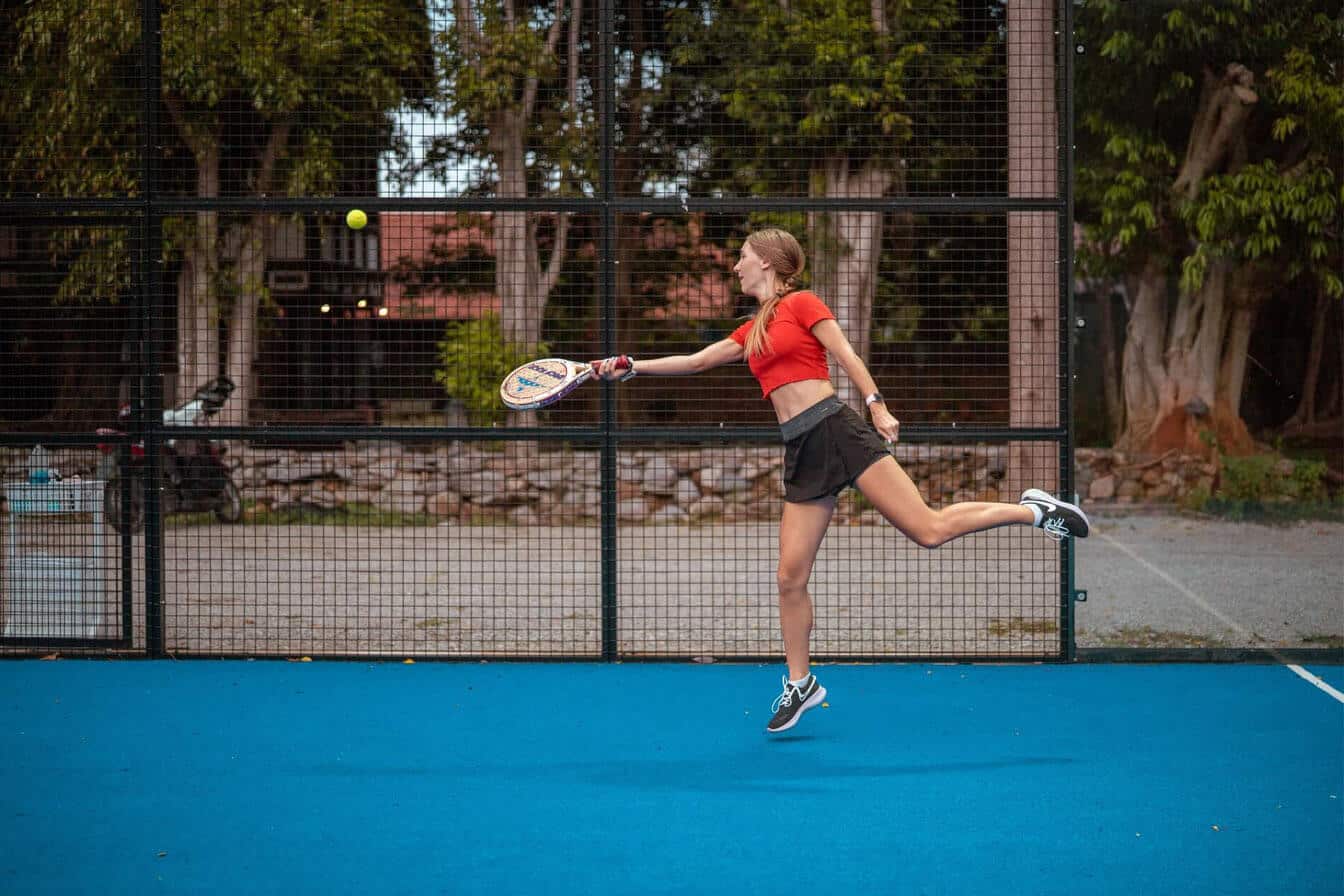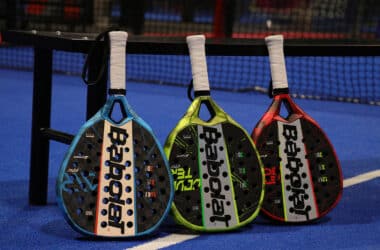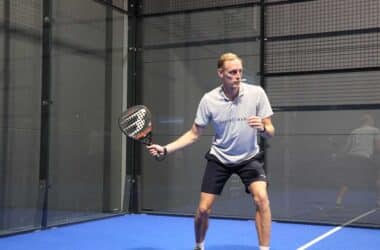We’ve put together what we think are the 21 best tips for padel beginners. Our padel tips for beginners are easy to understand and we’re confident they’ll make a difference to you in your next match.
Below you can see all the tips to navigate directly to what you want to read more about.
Table of contents
1. Choose a racket for your level of play
To make your game as enjoyable as possible, it’s important that you choose a racket that matches your experience in the sport and how fit you are. The general recommendation for beginners is to choose a racket that is round in shape and has a large sweetspot.
The balance point of these models is usually closer to the handle, which puts less stress on the wrist and elbow. A large sweetspot makes it easier to get good hits and therefore makes it easier to learn the game and later advance to a racket with more advanced techniques.
Learn more about the best padel racket for different levels:
2. Use padel shoes
The more often you play padel, the more important it becomes for you to invest in padel shoes. The way padel is played means that there are many sudden breaks and you often have to be quick to change directions on the court. As a result, it can be very stressful for the ankles if you don’t use shoes that have special protection in this area.
Padel shoes give you better stability, as the material is stiffer, and you have better control over your footwork. Take your time when testing padel shoes. They should have a good fit for your foot, so choose a width according to your foot so they are not too tight.
3. Warm up properly
No matter what form of exercise you’re going to engage in, it’s important to warm up your body. The main focus should be on your legs and torso, but it’s still a good idea to make sure your whole body is warm by jogging on the spot, for example.
Also do active stretching exercises for your legs and torso, such as forward lunges with stretching for both the front and back of your thighs and side lunges with a side stretch by stretching your arm above your head.
Make sure your ankles are well warmed up and ready for the twists and turns on the court. This includes standing on one leg and circling your foot in the air, in both directions. Circulate with your hands too, so your wrists warm up a bit to be able to handle the resistance from the ball and the racket. Finish with some explosive exercises, such as squat jumps.
4. Watch Youtube videos
There are lots of videos on Youtube where you can get tips on the basic moves and other techniques. Begin with your individual level and start with the basics. Practice at home in front of the mirror. It is beneficial to look at different players’ footwork and how to use your hip and core muscles, to get more power and relieve the small muscles in your wrist and elbow.
Even if you don’t want to think about possible mistakes, it can also be useful to watch videos where they go through common mistakes. What to avoid and why. It could be as simple as not forgetting to bend your legs more or not hitting too hard.
Don’t miss Elitepadel’s YouTube channel for reviews on different padel products and more padel tips.
5. Take lessons
Sure, it’s fun to play with friends or partners and learn from them, but a personal trainer who is an expert in the sport can probably teach you a lot more about technique and how to use your body’s movements. The coach can also focus on your body and how you play, and give specific tips on what you need to improve and how to go about doing it.
6. Learn the basics
As with most things you’re going to engage in, it’s always best to master the basics first before moving on. While it can be tempting to try different techniques that you see others doing, you’ll get very far with just the basics. If you move too fast, your development in the sport may take longer. As you develop in the basics, the game will flow better and it will be easier for you to advance further.
Learn more about the different strokes in padel:
7. Learn to play volleys
Unlike in the basics, here your racket is angled more upwards, in other words above wrist height. You step in towards the ball while swinging the racket towards the ball. The racket doesn’t follow the ball as far, as this stroke often doesn’t give you as much time.
8. Learn to play overhead
A stroke that is struck above the head and when you learn to master these strokes, you can get proper power and smash the ball away. When you’re a beginner, it can be a good idea to try to keep the ball at eye level, so you’re more confident that you’ll get in a good hit that doesn’t involve imbalance in the stroke.
Learn more about the different types of overhead strokes in padel:
9. Take over the net when the opportunity arises
If you can hit a good shot from the net, you can get in a good attacking ball with a lot of power. It can catch opponents off guard, who may be completely out of position. It can also be a great opportunity to try and get a good spin on the ball.
10. Hold the racket correctly
To begin with, it’s a good start if the thickness of the handle is correct, so you don’t have to hold the racket too tightly. If the handle is too thin, for example when your fingertips touch your palm, try wrapping it with grip strips.
The so-called Continental grip is also called Shaking Hands, as this is what it feels like when you grip your racket correctly. Think of the racket’s handle as a hand you grasp to greet.
11. Footwork
A good foundation is to remember not to stand still for too long and not to lean back on your heels. Then you’re just as ready to take off in a hurry. It is better to put your weight further forward on your foot and almost rock a little. This is a good starting point when you don’t know which way to run.
Quick feet are something you often benefit from in padel games but practice short quick steps instead of long ones. With short, small steps, it’s easier to maintain bent legs and you can more easily use explosive power when you’re going fast. Short quick steps also make it easier for you to move forward or backward quickly to get a good hit on the ball.
12. Bend your knees and get ready
Bending your legs allows you to take advantage of explosive power in different directions and also reduces your risk of injury. When you have your legs extended, many muscles are working in a fully extended position and you become generally stiff and almost a little clumsy. When you bend your legs, you also take the strain off your back.
13. Focus on precision over power
As a beginner, it’s better to focus primarily on precision. Then you’re more likely to hit the ball in the direction you want and even if you don’t use much power, you’re more likely to surprise your opponents. The better you get at precision, the easier you can so to speak fool your opponents. So they think the ball is going in a different direction.
With good power, you might be able to get the occasional smash, but if you haven’t worked up your precision, the smash might not be as good as intended. Even though you used a lot of power in the shot.
14. Learn to use the wall/glass
At first, it may feel unfamiliar to use the wall, as we are used to not using the wall from other sports. In padel, however, using the wall to hit a ball is often beneficial.
15. Communication
Good communication with your teammates always makes your game better. Tell each other where your opponents are and where they are going. This way it is easier for the player who is going to hit the ball to know how to think with his shot. There are quick moves in this sport and you don’t have time to keep track of everything and everyone at the same time.
16. Learn about positioning
Learning how to position yourself whether it’s for defense or attack is important to get a good flow in the game. For example, getting to the net quickly in attack and quickly backward in defense.
17. Play with better players than yourself
By playing with those who are better at padel than you, you will learn different basic techniques. For example, how to be active in your positioning and what it means to play attack or more on defense. Basically, the same thinking applies when playing with different players. Not only are we at different skill levels, but we all have different things we’re good at.
It can be good for you to learn from different players, whether they are a little or a lot better than you. Everyone has a different style of play and puts a higher focus on different things. Try different things from the players until you find your own style. Find your own player level in our table.
18. Learn that the team with the fewest mistakes usually wins the game
Making the fewest mistakes means, among other things, that there is good communication between the players in the team and that they are interacting. This can be a matter of practice at the beginning when you feel you have a lot of new things to learn and it may feel messy at times. But with good communication, two players who are very different in style of play and maybe even in experience can have a really good game.
19. Learn match tactics
When it comes to match tactics, there are many things to discuss and the better you get at padel, the more it sticks in your backbone. Study your opponents’ strengths and weaknesses.
How do they play to score points?
- If you see a weakness, then of course you should try to exploit it as much as possible to your advantage.
- Learn when you need to play with proper power or with good precision.
- Never stand completely still, be soft in the knees and always be ready for whatever may happen in the game.
- Don’t forget that the walls are your friends. They help you in the game and you can save your own muscle power.
- If you are playing doubles, keep in good contact with your fellow player and remember to have fun too.
20. Don't run too much
Even if you are very fit, padel is an explosive sport and you will tire quickly if you run a lot and have to be explosive. Try using different techniques with your racket or practicing your footwork. The better your footwork, the better you can move quickly in different directions.
21. Always be ready
Always being ready means being soft in the knees and having your center of gravity further forward on the foot instead of on the heel. Communicate with your teammates and keep an eye on how your opponents are moving on the pitch. If you’re always ready, you’re more likely to get good hits in without straining muscles and joints, and you won’t tire yourself out prematurely.
Summary of padel tips for beginners:
- Choose a padel racket for your level of play
- Use padel shoes
- Warm up properly
- Watch Youtube videos
- Take lessons
- Learn the basics
- Learn to play volleyball
- Learn to play overhead
- Take over the net when the opportunity arises
- Hold the racket correctly
- Take advantage of good footwork
- Bend your knees
- Focus on precision over power
- Learn to use the wall/glass
- Communication
- Learn correct positioning
- Play with better players than yourself
- Learn that the team with the fewest mistakes usually wins the match
- Learn match tactics
- Don’t run too much
- Always be ready







